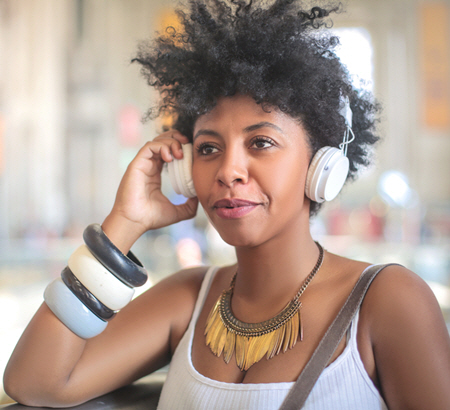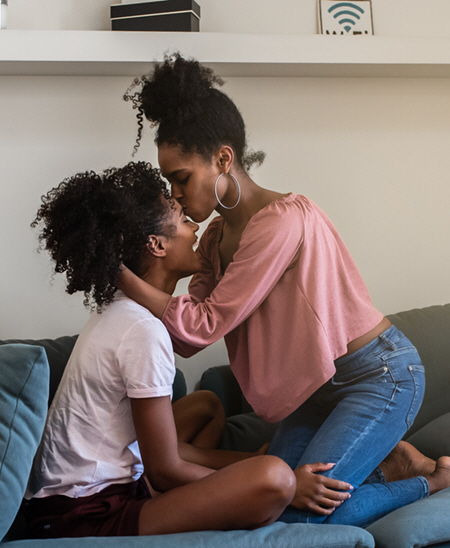Queer women of color deserve…
A place to be their full self…
To explain things without code-switching or leaving out parts of who they are…
To heal their trauma without risking further harm…
To see themselves reflected in the values and experience of those they work with…
To have their existence celebrated…
A therapist who gets them because she’s walked in their shoes…
 Carolina was no stranger to therapy.
Carolina was no stranger to therapy.
She’d worked with a couple of counselors in college… and there was even one more recently.
The counselors at her college didn’t have any shared identities, but she got what she needed at the time and felt proud of the work they did together.
Recently, she found someone to work with who was Latinx just like her. It was nice to talk about shared cultural values, like the importance of family and the tricky business of setting boundaries with elders. It was a really good fit.
That was… until Carolina shared that she had just gotten engaged to her long-time partner, Lisa.
“Yes, Lisa. A woman,” she responded when her therapist looked at her, confused. They hadn’t talked about her sexual orientation… or even her relationship. It just hadn’t come up until now.
“Pero tú no pareces lesbiana [you don’t look like a lesbian],” her therapist said. “I don’t understand.”
Carolina felt a knot in the pit of her stomach. It was happening again. She had gone through this before, sharing this part of her with someone new only to get a reaction like it wasn’t okay. Only this wasn’t just a fleeting relationship – this was with her therapist.
Carolina thought to herself,
“How am I expected to be vulnerable in a space where I have to hide parts of who I am?”
 Evelyn and Imani had been together since high school.
Evelyn and Imani had been together since high school.
They had met while attending the school’s cultural night and bonded when they realized their families had roots in neighboring islands.
The two were inseparable, and eventually, the friendship turned into more.
Evelyn’s family loved Imani like their own child. But despite Evelyn and Imani being open about their relationship, Evelyn’s immediate family wasn’t. They “accepted it” internally but didn’t share that information with relatives or friends. And they continued to call Imani her “friend,” despite them having been together romantically for ten years.
Evelyn felt like she lived two lives: the one she enjoyed at home, where it was her, Imani, and their dog, Noodles… and the “pretend one” when she went home for holidays where other family was around.
It was beginning to take a toll.
 Freddie provides a safe space for LGBTQIA+ students…
Freddie provides a safe space for LGBTQIA+ students…
… at the middle school where they work. They want students of diverse genders and sexual orientations to know they are welcome at the school. As a part of that, their office is filled with rainbow flags and posters profiling LGBTQ celebrities and prominent leaders.
Recently, some teachers complained that Freddie’s “agenda” is not fair to others with religious values against this type of expression, and their principal asked them to “tone it down.”
The teachers are okay with Freddie’s identity as long as they’re not “parading it everywhere.”
Freddie has begun thinking more and more about their painful experiences in middle school, where they were bullied for dressing in more masculine clothing and assumed to be gay.
Being your full self is essential to your progress in therapy.
How can you heal in an environment where a part of you has to be shut off or left outside the room?
How do you feel truly witnessed when your safety depends on hiding?
Carolina, Evelyn, and Freddie understood this, so they came to me.
A therapist who would tolerate them was not enough. They wanted to be affirmed… to be celebrated.
 I understand what it’s like to hide part of who you are.
I understand what it’s like to hide part of who you are.
I did a lot of hiding parts of myself growing up. I’d introduce myself and share things about my life, leaving out a big piece of the puzzle.
I used gender-neutral pronouns when talking about a same-sex crush or person I was seeing. I smiled and nodded when they assumed that person was male… and I didn’t dare correct them. I was scared I wouldn’t be accepted as me. Sometimes I even felt that way in therapy.
Therapists are trained to be a blank slate (newsflash: we’re not), and with this comes the expectation that we not share much about ourselves. I get it. As a client, I’ve had my share of therapy sessions where the person sitting across from me got more air time than what I was hoping to discuss that day. It’s really important the session remain centered on the client, not the therapist. But sometimes, a little self-disclosure can go a long way.
This is an invitation…
Throughout my career, I’ve heard colleagues share with clients about their husband or wife – not in any oversharing type of way… just as an aside like “Sorry, I had to take a call from my husband,” or “Oh, you’re from Charlotte?! My boyfriend’s family lives in Greensboro!” (I have no idea how far apart or close together those two cities are, but you get the point.)
I’ve intentionally decided to be openly queer as a therapist because it’s an instant confirmation to people like Freddie, Evelyn, and Carolina that I embrace who I am. And by embracing who I am, I can embrace who they are, too.
So, yes, I will openly support you in your full, authentic self!
I’d love to hold space for all of you. Use the button below to set up your free consultation.
Note: All names have been changed to protect confidentiality, and all scenarios are a composite and do not necessarily belong to one particular client.

